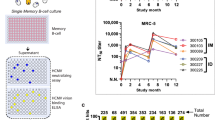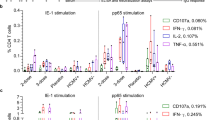Abstract
The immunogenicity of adenovirus (Ad) vectors is enhanced by virus-specific memory immune responses present in most individuals as a result of past exposure to these ubiquitous pathogens. We previously identified the first human T-cell epitope from the major capsid protein hexon, H910-924, and found that it is highly conserved among different Ad serotypes. Memory/effector T-cell responses to H910-924 were detected in 14 of 18 (78%) healthy adults by an interferon-γ ELISPOT assay. Hexon peptide-specific CD4 T-cell lines were generated from three HLA-typed donors and analyzed using a panel of HLA homozygous B-cell lines and monoclonal antibodies to HLA class II loci. These studies reveal that the hexon epitope is restricted by HLA DP4, a class II allele present in 75% of the population. Analysis of overlapping peptides and peptides with single residue mutations identified a HLA DP4-binding motif. Additionally, antibodies to the hexon peptide were detected in all donor sera by dot blot assay and ELISA. Therefore, most individuals exhibit both memory B- and T-cell responses to this highly conserved epitope on hexon, an obligate component of all Ad vectors, including ‘gutted’ vectors. These data suggest that current strategies for the use of Ad gene therapy vectors will not evade memory immune responses to Ad.
This is a preview of subscription content, access via your institution
Access options
Subscribe to this journal
Receive 12 print issues and online access
$259.00 per year
only $21.58 per issue
Buy this article
- Purchase on Springer Link
- Instant access to full article PDF
Prices may be subject to local taxes which are calculated during checkout



Similar content being viewed by others
References
Zhang Y et al. Acute cytokine response to systemic adenoviral vectors in mice is mediated by dendritic cells and macrophages. Mol Ther 2001; 3: 697–707.
Yang Y, Su Q, Wilson JM . Role of viral antigens in destructive cellular immune responses to adenovirus vector-transduced cells in mouse lungs. J Virol 1996; 70: 7209–7212.
Schmitz H, Wigand R, Heinrich W . Worldwide epidemiology of human adenovirus infections. Am J Epidemiol 1983; 117: 455–466.
Flomenberg P et al. Increasing incidence of adenovirus disease in bone marrow transplant recipients. J Infect Dis 1994; 169: 775–781.
Koneru B et al. Adenoviral infections in pediatric liver transplant recipients. JAMA 1987; 258: 489–492.
Flomenberg P, Piaskowski V, Truitt RL, Casper JT . Characterization of human proliferative T cell responses to adenovirus. J Infect Dis 1995; 171: 1090–1096.
Smith CA, Woodruff LS, Rooney C, Kitchingman GR . Extensive cross-reactivity of adenovirus-specific cytotoxic T cells. Hum Gene Ther 1998; 9: 1419–1427.
Olive M et al. The adenovirus capsid protein hexon contains a highly conserved human CD4+ T-cell epitope. Hum Gene Ther 2002; 13: 1167–1178.
Rux JJ, Burnett RM . Type-specific epitope locations revealed by X-ray crystallographic study of adenovirus type 5 hexon. Mol Ther 2000; 1: 18–30.
Castelli FA et al. HLA-DP4, the most frequent HLA II molecule, defines a new supertype of peptide-binding specificity. J Immunol 2002; 169: 6928–6934.
al Daccak R et al. Gene polymorphism of HLA-DPB1 and DPA1 loci in caucasoid population: frequencies and DPB1-DPA1 associations. Hum Immunol 1991; 31: 277–285.
Charron D et al. Genetic diversity of HLA, functional and medical implication. In: Charron D (ed). XIIth International Histocompatibility Workshop and Conference. EDK: Paris, 1997.
Zeng G et al. CD4(+) T cell recognition of MHC class II-restricted epitopes from NY-ESO-1 presented by a prevalent HLA DP4 allele: association with NY-ESO-1 antibody production. Proc Natl Acad Sci USA 2001; 98: 3964–3969.
Schultz ES et al. A MAGE-A3 peptide presented by HLA-DP4 is recognized on tumor cells by CD4+ cytolytic T lymphocytes. Cancer Res 2000; 60: 6272–6275.
Celis E, Larson J, Otvos Jr L, Wunner WH . Identification of a rabies virus T cell epitope on the basis of its similarity with a hepatitis B surface antigen peptide presented to T cells by the same MHC molecule (HLA-DPw4). J Immunol 1990; 145: 305–310.
Celis E, Karr RW . Presentation of an immunodominant T-cell epitope of hepatitis B surface antigen by the HLA-DPw4 molecule. J Virol 1989; 63: 747–752.
Schuler-Thurner B et al. Rapid induction of tumor-specific type 1T helper cells in metastatic melanoma patients by vaccination with mature, cryopreserved, peptide-loaded monocyte-derived dendritic cells. J Exp Med 2002; 195: 1279–1288.
Rajnavolgyi E et al. A repetitive sequence of Epstein–Barr virus nuclear antigen 6 comprises overlapping T cell epitopes which induce HLA-DR-restricted CD4(+) T lymphocytes. Int Immunol 2000; 12: 281–293.
Gogolak P et al. Mapping of a protective helper T cell epitope of human influenza A virus hemagglutinin. Biochem Biophys Res Commun 2000; 270: 190–198.
Bhardwaj N et al. Influenza virus-infected dendritic cells stimulate strong proliferative and cytolytic responses from human CD8+ T cells. J Clin Invest 1994; 94: 797–807.
Schiedner G et al. Genomic DNA transfer with a high-capacity adenovirus vector results in improved in vivo gene expression and decreased toxicity. Nat Genet 1998; 18: 180–183.
Xiang Z et al. Novel, chimpanzee serotype 68-based adenoviral vaccine carrier for induction of antibodies to a transgene product. J Virol 2002; 76: 2667–2675.
Reddy PS et al. The immunogenicity and efficacy of replication-defective and replication-competent bovine adenovirus-3 expressing bovine herpesvirus-1 glycoprotein gD in cattle. Vet Immunol Immunopathol 2000; 76: 257–268.
Yang SY, Milford E, Hammerling U, Dupont B . Immunobiology of HLA. In: Dupont B (ed) Histocompatibility Testing 1987, Vol. I. Srpinger-Verlag: New York, 1989, pp 11–19.
Olive M, Eisenlohr LC, Flomenberg P . Quantitative analysis of adenovirus-specific CD4+ T cell responses from healthy adults. Viral Immunol 2001; 14: 403–413.
Acknowledgements
We thank Dr D Eckels for the gift of the HLA homozygous B-cell lines. We especially thank all of the participants who donated blood for this study. This research was supported by grants from the National Institutes of Health (RO1 AI42842) and GlaxoSmithKline.
Author information
Authors and Affiliations
Rights and permissions
About this article
Cite this article
Tang, J., Olive, M., Champagne, K. et al. Adenovirus hexon T-cell epitope is recognized by most adults and is restricted by HLA DP4, the most common class II allele. Gene Ther 11, 1408–1415 (2004). https://doi.org/10.1038/sj.gt.3302316
Received:
Accepted:
Published:
Issue Date:
DOI: https://doi.org/10.1038/sj.gt.3302316
Keywords
This article is cited by
-
CRISPR/Cas9 delivery with one single adenoviral vector devoid of all viral genes
Scientific Reports (2017)
-
Getting genetic access to natural adenovirus genomes to explore vector diversity
Virus Genes (2017)
-
Discovery of immunodominant T-cell epitopes reveals penton protein as a second immunodominant target in human adenovirus infection
Journal of Translational Medicine (2016)
-
Virus-specific T-cell banks for 'off the shelf' adoptive therapy of refractory infections
Bone Marrow Transplantation (2016)
-
Optimization of vaccine responses with an E1, E2b and E3-deleted Ad5 vector circumvents pre-existing anti-vector immunity
Cancer Gene Therapy (2009)



